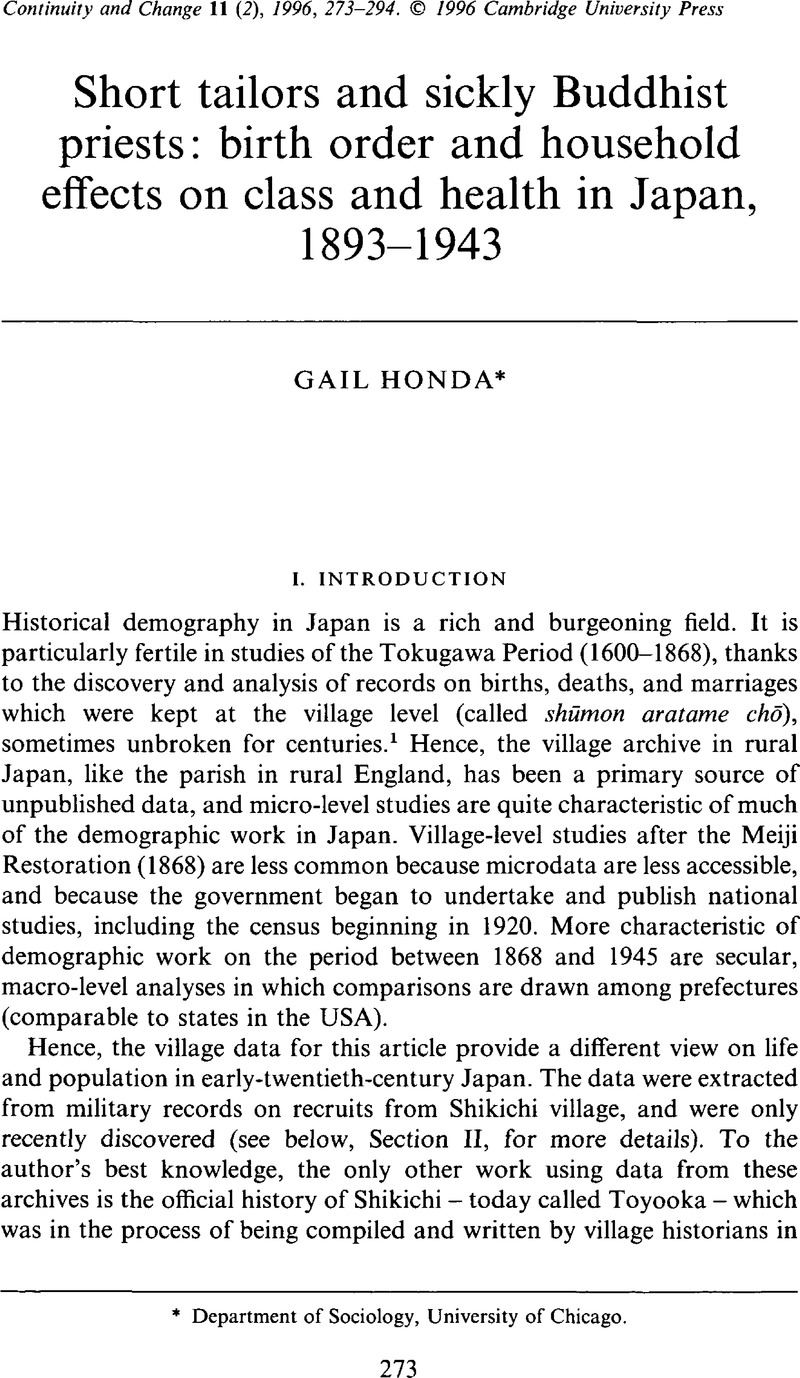No CrossRef data available.
Article contents
Short tailors and sickly Buddhist priests: birth order and household effects on class and health in Japan, 1893–1943
Published online by Cambridge University Press: 11 November 2008
Abstract

- Type
- Articles
- Information
- Copyright
- Copyright © Cambridge University Press 1996
References
ENDNOTES
1 Akira Hayami is the pioneer in this field; see Cornell, L. L. and Hayami, Akira, ‘The shūmon aratame chō: Japan's population registers’, Journal of Family History 11 (1986), 311–28.CrossRefGoogle Scholar
2 Interest in this topic has been spurred by international conferences such as the one entitled ‘Dimensions of inequalities among siblings’ held in Siena in July 1991, papers from which were published in the December 1992 issue of Continuity and Change.
3 Fukutake, Tadashi, The Japanese social structure, trans. Dore, Ronald P., 2nd edn. (Tokyo, 1989), 41–2.Google Scholar
4 Saga, Junichi, Memories of silk and straw: a self-portrait of small-town Japan, trans. Evans, Garry (New York, 1990), 178–9.Google Scholar
5 Fukutake, , The Japanese social structure, 20.Google Scholar
6 Birth-order data were available for males only. I hope that a similar study on females might someday be conducted.
7 Trewartha, Glenn, Japan: a physical, cultural, and regional geography (Madison, Wisconsin, 1945), 97, 194.Google Scholar
8 I am grateful to Osamu Saitō for bringing this article to my attention.
9 Sōmuchō tōkei kyoku (General Affairs Office Statistical Bureau), Nihon chōki tōkei sōran (Historical statistics of Japan), vol. 5 (Tokyo, 1978), 212–31.Google Scholar
10 One village historian I worked with in another prefecture was a graduate of prewar middle and normal school and had worked as an elementary school teacher. Others spoke of him as an iri-to (elite). Whereas the standard number of kanji characters of the Japanese language required for the modern educated reader of Japanese newspapers is 3,000, this former elementary school teacher claimed to know 50,000.
11 I asked a Japanese graduate student, Mr Y, to assist me with the reading comprehension examinations. They were written in a form of Japanese used in the prewar era which differs in conjugation and syntax from the Japanese language in current usage. Mr Y is in the Ph.D programme in the Department of History at the University of Chicago and received his bachelor's and master's degrees in Japanese literature from Tokyo University. Tokyo University is considered to be the most elite institution of higher education in Japan, entrance to which is notorious for its extreme competitiveness. Even without allowing for the prewar Japanese, even Mr Y experienced some trouble untangling the meaning of the examinations for Levels 4 and 5.
12 Only 480 of the 600 are listed here because educational level was not given for the other 120. Because the sample size is small, conclusions drawn from statistical analyses of the numbers are made with reserve. Nevertheless, the data linking birth order, education, and health are unusually rich and are virtually complete for this village and time period.
13 I thank Kipp Martin for this suggestion. Since the probability of having another household member with the same educational level increases with household size, this analysis assumes that household size is evenly distributed over the educational categories. There is no strong evidence to suggest the contrary – for example, that university-educated households were much larger on average than middle- and normal-school educated households – especially since ‘household’ here refers to everyone who lived at a particular address over the thirty-year period which the data span. The point is that we know more about a recruit's educational level if we know something about the educational level of another household member, especially at the ends of the educational spectrum.
14 It is unfortunate that the records do not distinguish among important categories of farmers such as jinushi (landlord), jisaku (owner-farmer), ji-kosaku (owner-tenant farmer), and kosaku (tenant farmer). Knowledge of landholding status would provide more useful information about socioeconomic status.
15 Preservation of the household was not an institution limited to Japan. Eldest and younger sons of the nobility in sixteenth-century Italy, for example, were expected to contribute to the ‘splendour of the family’. Eldest sons contributed through the dowry of their wives and younger sons through the proceeds of their ecclesiastical career. See Ago, Renata, ‘Ecclesiastical careers and the destiny of cadets’, Continuity and Change 7 (3) (1992), 271–82.CrossRefGoogle Scholar
16 Although the sickliest category in the study in Table 1 was that of Buddhist priests, there is no confirmation of this in the individual records in HSIG. The one Shinto priest in the individual records was a first-born son with no health rating given.
17 See Fogel, Robert, ‘Economic growth, population theory, and physiology: the bearing of long-term processes on the making of economic policy’ (paper prepared for presentation as the Prize Lecture in Economic Sciences in Memory of Alfred Nobel, 9 12 1993)Google Scholar; Floud, Roderick, Wachter, Kenneth, and Gregory, Annabel, Height, health and history (Cambridge, 1990)CrossRefGoogle Scholar; and Eveleth, Phyllis and Tanner, J. M., Worldwide variation in human growth, 2nd edn (Cambridge, 1990).Google Scholar
18 Craft occupations include tailor, net-maker, lacquerer, dyer, mat-maker, cabinet-maker, woodworker, brewer, plasterer, carpenter, housefitter, stonemason, swordsmith, candle-maker, tabi-maker (the tabi is the Japanese sock), umbrella-maker, blacksmith, cooper and confectioner.


